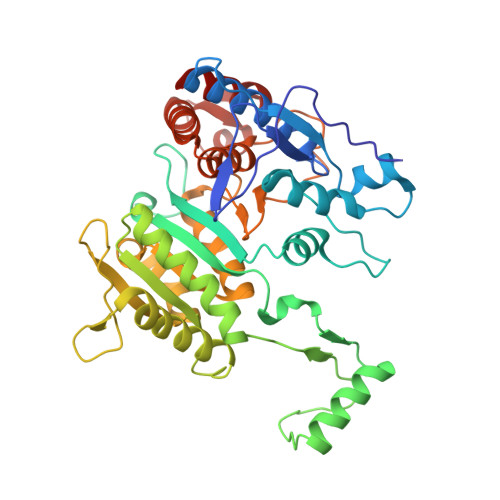Active site water molecules revealed in the 2.1 A resolution structure of a site-directed mutant of isocitrate dehydrogenase.
Cherbavaz, D.B., Lee, M.E., Stroud, R.M., Koshland Jr., D.E.(2000) J Mol Biol 295: 377-385
- PubMed: 10623532
- DOI: https://doi.org/10.1006/jmbi.1999.3195
- Primary Citation of Related Structures:
1CW1, 1CW4, 1CW7 - PubMed Abstract:
Isocitrate dehydrogenase catalyses the two step, acid base, oxidative decarboxylation of isocitrate to alpha-ketoglutarate. Lysine 230 was suggested to act as proton donor based on geometry and spatial proximity to isocitrate. To clarify further the role of lysine 230, we co-crystallized the lysine-to-methionine mutant (K230M) with isocitrate and with alpha-ketoglutarate. Crystals were flash-frozen and the two structures were determined and refined to 2. 1 A. Several new features were identified relative to the wild-type structure. Seven side-chains previously unplaced in the wild-type structure were identified and included in the model, and the amino acid terminus was extended by an alanine residue. Many additional water molecules were identified. Examination of the K230M active sites (K230M isocitrate and K230M-ketoglutarate) revealed that tyrosine 160 protrudes further into the active site in the presence of either isocitrate or alpha-ketoglutarate in K230 M than it does in the wild-type structure. Also, methionine 230 was not as fully extended, and asparagine 232 rotates approximately 30 degrees toward the ligand permitting polar interactions. Outside the active site cleft a tetragonal volume of density was identified as a sulfate molecule. Its location and interactions suggest it may influence the equilibrium between the tetragonal and the orthorhombic forms of isocitrate dehydrogenase. Differences observed in the active site water structure between the wild-type and K230M structures were due to a single point mutation. A water molecule was located in the position equivalent to that occupied by the wild-type epsilon-amine of lysine 230; a water molecule in that location in K230M suggests it may influence catalysis in the mutant. Comparison of K230M complexed with isocitrate and alpha-ketoglutarate illuminates the influence a ligand has on active site water structure.
Organizational Affiliation:
Department of Biochemistry, University of California, San Francisco, San Francisco, CA, 94143-0448, USA.

















